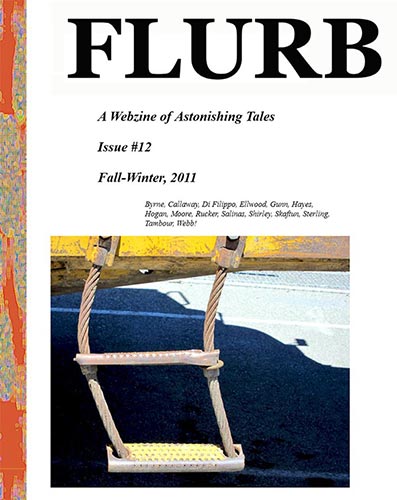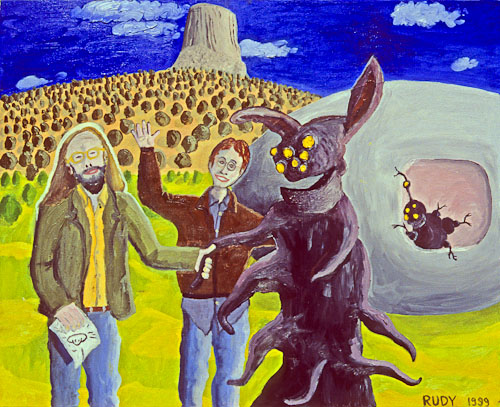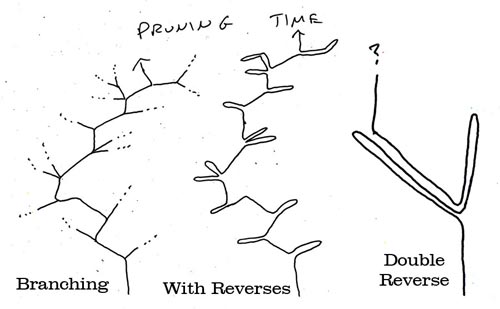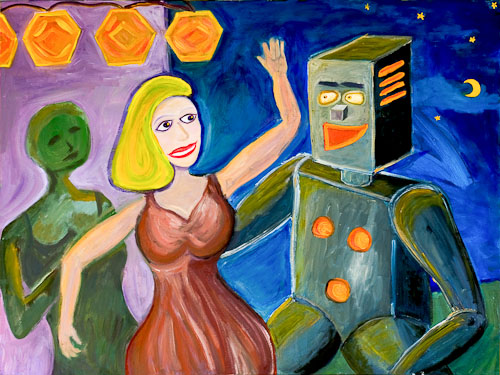Tanenbaum's Law (attributed to Professor Andrew S. Tanenbaum) is flippantly expressed as, "Never underestimate the bandwidth of a station wagon full of tapes hurtling down the highway". It's a profound insight into the state of networking technology: our ability to move bits from a to b is very tightly constrained in comparison with our ability to move atoms, because we have lots of atoms and they take relatively little energy to set in motion.
Which leads me to ask the following question:
1. Postulate that we make contact in the near future with an extra-terrestrial intelligence ten light-years away.
2. We can communicate with them (and want to communicate with them) by two means: we can beam data at them via laser, or we can send a physical data package (a "tape" travelling cross-country).
3. Our "tape" package will be made of something approximating the properties of memory diamond, i.e. on the order of 1022 bits/gram.
4. We will assume that we can use a laser-pumped light sail (with laser efficiency of 10%) to transfer momentum directly to a hunk of memory diamond. We're going to ignore the sail mass, to keep things simple. And we're going to assume there's another laser at the other end to allow our alien friends to decelerate it (so if you need xGj/gram to reach a specific speed, we can allow for 2x Gj/gram for the trip).
5. Our reference interstellar comms laser, for an energy input of 1GW, will be able to deliver 2.6 billion photons/second to a suitable receiver 10 light years away, while switching at 1Hz. If we increase the bit rate we decrease the number of photons per bit, so this channel probably limits out at significantly less than 1Gbit/sec (probably by several orders of magnitude). I'm going to arbitrarily declare that for starting purposes our hyper-sensitive detectors need 1000 photons to be sure of a bit (including error correction), so we can shift 2.6mb/sec using a 1Gw laser.
6. Ignoring latency (it will be one year per light year for lasers, higher for physical payloads), which is the most energetically efficient way to transfer data, and for a given energy input, how much data can we transfer per channel?
Here's my initial stab at it, which is probably wrong (because it's a Saturday night, I've been working for the past nine hours or so, and I'm fried):
Let's pick a 10 year time-frame first. 10 years = 315,576,000 seconds.
Laser:
Running a laser for 10 years will emit 3.56 x 1017 joules in that time, at 10% efficiency, so roughly 3.56 x 1018 joules of energy is consumed. It will deliver 0.82 x 1014 bits of data. So, roughly 4000 joules/bit.
"Tape":
A packet of memory diamond with a capacity of 1 x 1014 bits has a mass of roughly 10-8 grams.
Kinetic energy of 10-8g travelling at 10% of c (30,000 km/sec, 30,000,000 m/s) = (10-8 * 30,000,0002)/2 = 0.9 * 106 J. Double the energy for deceleration and we still have 2 x 106 joules, to move 1014 bits. So, roughly 108 bits/joule.
Eh?
Let's dink with the variables a bit. Even if we allow individual photons to count as bits at 10 light years' range, our laser still maxes out at around 4 joules/bit. And even if we allow for a 10,000:1 mass ratio for our data-carrying starwisp, and impose the same 10% efficiency on its launch laser's energy conversion as on our communication laser, we get 1,000 bits/joule out of it.
As long as we ignore latency/speed issues, it looks to me as if Tanenbaum's Law implies a huge win for physical interstellar comms over signalling. Which in turn might imply an answer to the SETI silence aspect of the Fermi paradox.
Of course, this is just an idle back-of-the-envelope amusement and I've probably borked my calculations somewhere. Haven't I?








